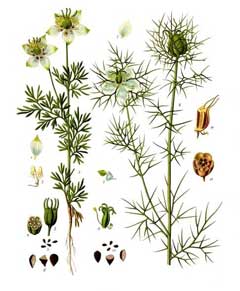 |
|
http://commons.wikimedia.org/wiki/File:Nigella_sativa_from_Koeh-227.png |
 |
| http://commons.wikimedia.org/wiki/User:Llez |
Translate this page:
Summary
The common name used, Black cumin, is also used for the seeds of Bunium persicum which are a similar shape, but their color is darker brown. When crushed Bunium persicum seeds are highly aromatic, almost piney and less earthy than Nigella seeds. The flavor of Bunium persicum is similarly pine-like, astringent, and bitter.
Physical Characteristics

 Nigella_sativa is a ANNUAL growing to 0.4 m (1ft 4in) by 0.2 m (0ft 8in).
Nigella_sativa is a ANNUAL growing to 0.4 m (1ft 4in) by 0.2 m (0ft 8in).
It is not frost tender. It is in flower in July, and the seeds ripen in September. The species is hermaphrodite (has both male and female organs) and is pollinated by Bees.
Suitable for: light (sandy), medium (loamy) and heavy (clay) soils and prefers well-drained soil. Suitable pH: mildly acid, neutral and basic (mildly alkaline) soils. It cannot grow in the shade. It prefers dry or moist soil.
UK Hardiness Map
US Hardiness Map
Synonyms
Plant Habitats
Edible Uses
Seed - raw or cooked. Normally used as a flavouring on bread, cakes, curries, pickles etc[4, 9, 74, 100, 183]. There is a belief that eating the seed will make a woman's breasts plumper[245]. The seed is a very popular spice from the Mediterranean to India. It has a pungent flavour according to one report[46] whilst another says that it has a spicy fruity taste[238] and a third that the scent is somewhat like nutmeg[245]. The immature seed is bitter, but when fully ripe it is aromatic[9]. It is also used as a pepper substitute[4].
References More on Edible Uses
Medicinal Uses
Plants For A Future can not take any responsibility for any adverse effects from the use of plants. Always seek advice from a professional before using a plant medicinally.
Like many aromatic culinary herbs, the seeds of black cumin are beneficial for the digestive system, soothing stomach pains and spasms and easing wind, bloating and colic[254]. The ripe seed is anthelmintic, carminative, diaphoretic, digestive, diuretic, emmenagogue, galactogogue, laxative and stimulant[4, 9, 46, 238, 240]. An infusion is used in the treatment of digestive and menstrual disorders, insufficient lactation and bronchial complaints[9, 238]. The seeds are much used in India to increase the flow of milk in nursing mothers and they can also be used to treat intestinal worms, especially in children[254]. Externally, the seed is ground into a powder, mixed with sesame oil and used to treat abscesses, haemorrhoids and orchitis[238, 240]. The powdered seed has been used to remove lice from the hair[245].
References More on Medicinal Uses
The Bookshop: Edible Plant Books
Our Latest books on Perennial Plants For Food Forests and Permaculture Gardens in paperback or digital formats.

Edible Tropical Plants
Food Forest Plants for Hotter Conditions: 250+ Plants For Tropical Food Forests & Permaculture Gardens.
More

Edible Temperate Plants
Plants for Your Food Forest: 500 Plants for Temperate Food Forests & Permaculture Gardens.
More

More Books
PFAF have eight books available in paperback and digital formats. Browse the shop for more information.
Shop Now
Other Uses
The aromatic seed contains about 1.5% essential oil[240]. It is placed amongst clothes etc to repel moths[4]. The seeds can also be put in muslin bags and hung near a fire when they will fill the room with their delicious scent[245]. They need to be changed about every three weeks[245]. The seed contains 35% of a fatty oil[74, 240].
Special Uses
References More on Other Uses
Cultivation details
Easily grown in any good garden soil, preferring a sunny position[1, 108]. Prefers a light soil in a warm position[37]. This species is often cultivated, especially in western Asia and India, for its edible seed[2]. The seed is aromatic with a nutmeg scent[245]. A greedy plant, inhibiting the growth of nearby plants, especially legumes[54].
References Carbon Farming Information and Carbon Sequestration Information
Temperature Converter
Type a value in the Celsius field to convert the value to Fahrenheit:
Fahrenheit:
The PFAF Bookshop
Plants For A Future have a number of books available in paperback and digital form. Book titles include Edible Plants, Edible Perennials, Edible Trees,Edible Shrubs, Woodland Gardening, and Temperate Food Forest Plants. Our new book is Food Forest Plants For Hotter Conditions (Tropical and Sub-Tropical).
Shop Now
Plant Propagation
Seed - sow spring or early autumn in situ[1]. The autumn sowing might not be successful in harsh winters. Plants can be transplanted if necessary[200].
Other Names
If available other names are mentioned here
Native Range
TEMPERATE ASIA: Iraq, Turkey
Weed Potential
Right plant wrong place. We are currently updating this section.
Please note that a plant may be invasive in one area but may not in your area so it’s worth checking.
Conservation Status
IUCN Red List of Threatened Plants Status :

Growth: S = slow M = medium F = fast. Soil: L = light (sandy) M = medium H = heavy (clay). pH: A = acid N = neutral B = basic (alkaline). Shade: F = full shade S = semi-shade N = no shade. Moisture: D = dry M = Moist We = wet Wa = water.
Expert comment
Author
L.
Botanical References
5074
Links / References
For a list of references used on this page please go here
Readers comment